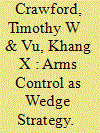| Srl | Item |
| 1 |
ID:
181390


|
|
|
|
|
| Summary/Abstract |
Strategic arms control is in crisis. The United States and Russia have retreated from agreements that formed the framework for post–Cold War arms cuts and strategic stability, such as the Anti-Ballistic Missile Treaty, the Treaty on Conventional Armed Forces in Europe, and the Intermediate-Range Nuclear Forces Treaty. The only strategic arms control agreement between the United States and Russia (i.e., New START) expires in 2026. The political forcefield that sustained the old framework has been altered by major technological revolutions and China's rise. Motives for strategic arms control are conventionally framed in terms of their potential to enhance stability by limiting certain weapons, avoiding costly arms races, or preserving military advantage. But states can also use strategic arms control to divide adversaries. Wedge strategy theory explains how arms control can do so by affecting adversaries' threat perceptions, their beliefs about the costs and benefits of formal commitments, and their degree of trust in one another. Three landmark strategic arms control negotiations (the Five-Power Treaty and the Four-Power Treaty at the Washington Naval Conference, the Limited Nuclear Test Ban Treaty, and the Strategic Arms Limitation Talks) show how the wedge motive informed these negotiations and influenced great power relations. The wedge logic remains relevant today. For example, the United States may employ future arms control agreements to drive a wedge between China and Russia, and it must be cautious about arms control deals with North Korea that would negatively affect its relationship with South Korea.
|
|
|
|
|
|
|
|
|
|
|
|
|
|
|
|
| 2 |
ID:
181992


|
|
|
|
|
| Summary/Abstract |
The United States and Russia must take the decision to extend the New START nuclear arms control treaty for five years by February, 2021 or the agreement will expire. Extension of New START will temporarily freeze the existing status quo as between the two leading nuclear powers and create breathing space for further and more extensive talks on a number of matters. These other issues could include: non-strategic nuclear forces; missile defenses; long-range conventional strike and hypersonic weapons; space arms control; and, the possibility of bringing China into future nuclear arms control discussions. Going forward, both the U.S. and Russia will have to balance their plans for nuclear modernization against the desire for some bilateral restraints made possible by arms control.
|
|
|
|
|
|
|
|
|
|
|
|
|
|
|
|